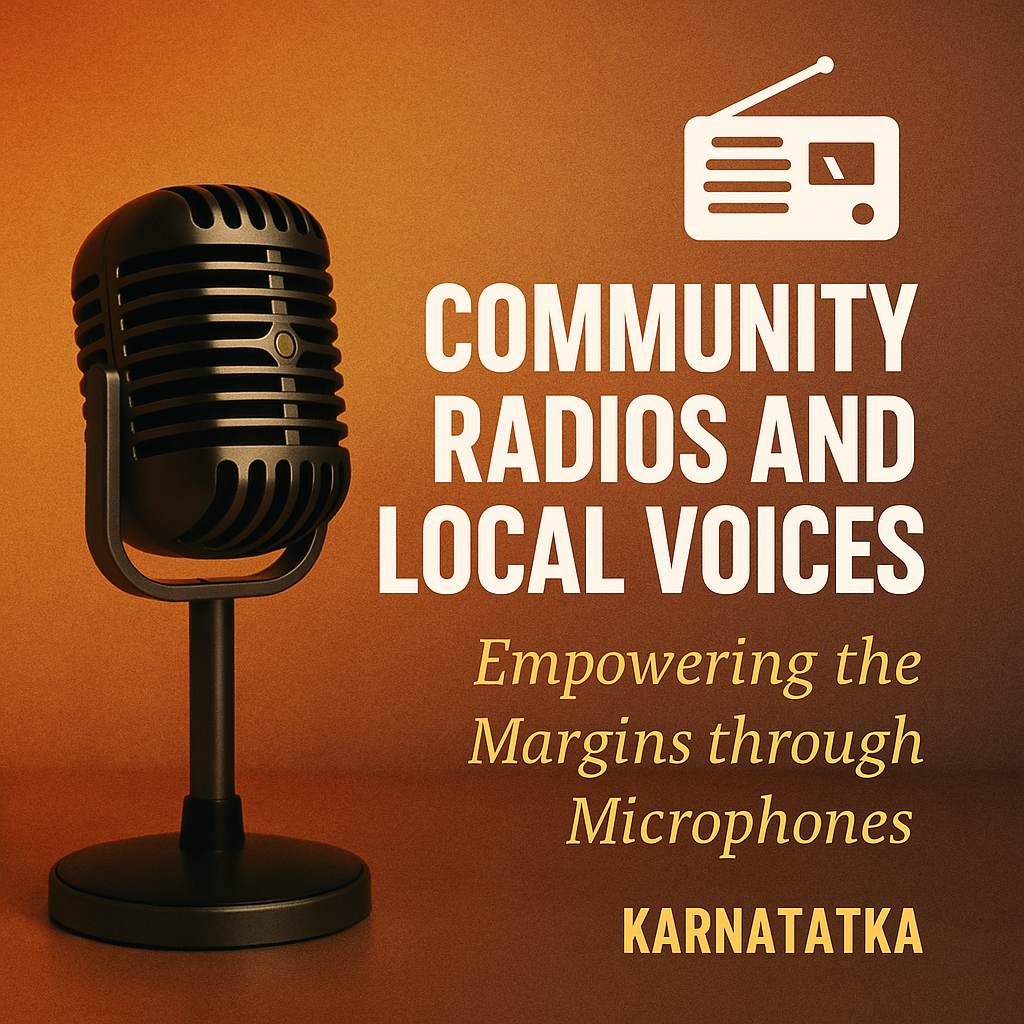📡 Community Radios and Local Voices in Karnataka

📡 Community Radios and Local Voices in Karnataka
Empowering Marginalized Communities Through Grassroots Media
In a culturally diverse and linguistically rich state like Karnataka, community radio has emerged as a powerful tool for grassroots communication, enabling tribal, rural, and underrepresented communities to voice their concerns, share local knowledge, and access critical information. Unlike mainstream media that often overlooks hyperlocal issues, community radios speak in the language of the people, both literally and figuratively.
📻 What Is Community Radio and Why It Matters
Community radio is a low-power FM station, run by and for a specific community be it a village, a farming belt, a tribal settlement, or a coastal area. These stations broadcast in local dialects, discuss relevant issues, and promote participatory communication. Unlike commercial radio, community radios do not chase ratings they chase impact.
In Karnataka, they are lifelines for:
-
🧑🌾 Farmers in drought-prone regions needing weather updates, seed info, or market rates
-
👩⚕️ Women’s groups sharing health and hygiene practices in rural areas
-
🎓 Students receiving educational support where schools are understaffed
-
🌲 Tribal populations preserving their oral histories, folk songs, and traditional medicine
📡 Prominent Community Radio Stations in Karnataka
-
Radio Siddhartha (Tumkur): Run by Siddhartha College, it delivers local news, health alerts, and civic announcements.
-
Radio Sarang 107.8 FM (Mangaluru): Operated by St. Aloysius College, it empowers fisherfolk, labourers, and local artisans through inclusive programming.
-
Namma Dhwani (Budikote): One of India’s earliest community radios, focusing on women, rural governance, and education in rural Karnataka.
-
Radio Active 90.4 MHz (Bengaluru): India’s first urban community radio, it covers issues from waste management to LGBTQ+ rights, often in Kannada and multiple urban dialects.
These stations often invite locals as presenters, allowing ordinary people to become broadcasters, activists, and storytellers.
🌐 Bridging the Digital Divide
Many community radios in Karnataka now complement their broadcasts with podcasts, mobile apps, and WhatsApp audio bulletins. This ensures the reach goes beyond FM bandwidth and taps into mobile-first users in remote areas.
For example, Radio Sarang’s COVID-19 awareness programs were shared as WhatsApp audios, reaching thousands of non-internet users in coastal regions during lockdowns.
🎙️ Community Radio vs. Mainstream Media
| Community Radio | Mainstream Media |
|---|---|
| Hyperlocal issues (e.g., village water scarcity) | National/state headlines |
| Citizen participation | Top-down reporting |
| Regional dialects, folk culture | Standard Kannada or English |
| Non-commercial, people-funded | Corporate or advertiser-funded |
This contrast shows that community radios fill a gap that traditional and digital media often miss, especially in Kannada-speaking rural and tribal belts.
🤝 How BMA (Bharat Media Association) Supports Community Radio
Bharat Media Association recognizes the vital role of community radios in building media democracy. Here's how BMA strengthens their mission:
-
🛠️ Capacity Building: Technical training on equipment, editing, broadcasting, and field reporting
-
🧾 Legal Help: Assisting with licensing, compliance with Ministry of Information & Broadcasting rules
-
📢 Platform Amplification: Helping community radio stories reach national and state-level policymakers
-
💡 Funding Assistance: Connecting radios to CSR programs, development grants, and NGO partnerships
-
🗣️ Recognition & Certification: Rewarding excellence in grassroots journalism and innovation
BMA also conducts Community Media Fellowships, encouraging local reporters to research, document, and amplify rural voices with guidance from professional mentors.
💬 Real Impact Stories
-
A community radio in Chamarajanagar helped tribal women form a self-help group after an on-air success story.
-
Farmers in Kolar began using drip irrigation after listening to weekly agricultural advisory programs.
-
During floods in North Karnataka, a local station broadcast real-time safety instructions, saving dozens of families.
These examples prove that community radio is not just a medium—it’s a movement.
🧭 Conclusion
In Karnataka, where diversity is both cultural and geographic, community radios act as trusted local guides, development partners, and cultural custodians. Their ability to listen, respond, and reflect local realities makes them indispensable in the media landscape.
With sustained backing from organizations like Bharat Media Association, community radio can grow into a stronger, more resilient force preserving Kannada heritage, empowering underserved voices, and contributing to an inclusive, participatory democracy.
- Goa
- Jammu & Kashmir
- Punjab
- Uttar Pradesh
- Uttarkhand
- Andaman & Nikobar Islands
- Andhra Pradesh
- Karnataka
- Kerala
- Lakshdweep
- Puducherry
- Tamilnadu
- Telangana
- Dadra &Nager Haveli, Daman &Diu
- Himachal Pradesh
- Gujarat
- Madhya Pradesh
- Maharashtra
- Rajasthan
- Legal
- Life Style
- Music
- Prop News
- Sports
- Technology
- SURAKSHA
- Education
- International
- Haryana
- BMA
- Bharat
- Business
- Entertainment
- Fashion & Beauty
- Health & Fitness
- Arunachal Pradesh
- Assam
- Bihar
- Chattisgarh
- Jharkhand
- Ladakh
- Manipur
- Meghalaya
- Mizoram
- Nagaland
- Odisha
- Sikkim
- Tripura
- West Bengal
- Chandigarh
- Delhi - NCR
- Bharat Aawaz
- IINNSIDE
- Business EDGE
- Media Academy



